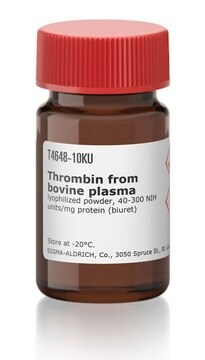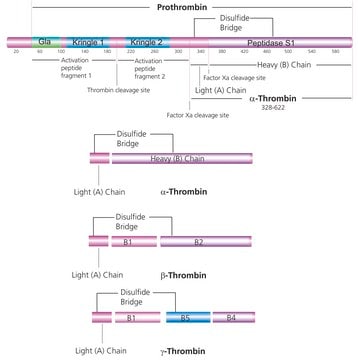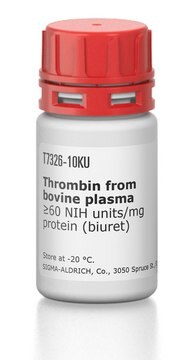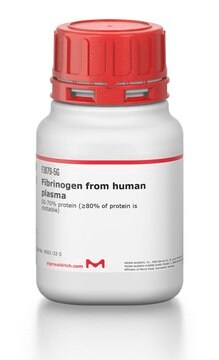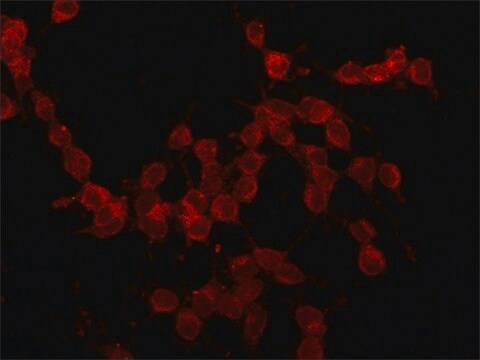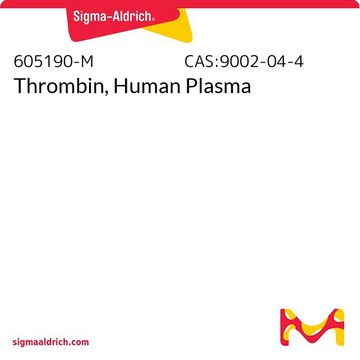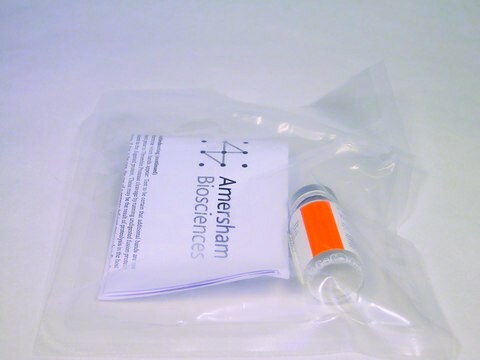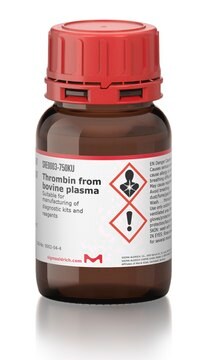Kluczowe dokumenty
T6884
Thrombin from human plasma
lyophilized powder, ≥2,000 NIH units/mg protein (E1%/280, 18.3)
Synonim(y):
Factor IIa
About This Item
Polecane produkty
pochodzenie biologiczne
human plasma
Poziom jakości
Formularz
lyophilized powder
aktywność właściwa
≥2,000 NIH units/mg protein (E1%/280, 18.3)
masa cząsteczkowa
37.4 kDa
zanieczyszczenia
HIV and HBsAg, source material tested negative
numer dostępu UniProt
temp. przechowywania
−20°C
informacje o genach
human ... F2(2147)
Szukasz podobnych produktów? Odwiedź Przewodnik dotyczący porównywania produktów
Opis ogólny
Zastosowanie
- in the preparation of fibrin gels for assessing human bone marrow stromal cells (hBMSC) morphology,
- in the activation of platelets,
- to evaluate the integrity of endothelial cell (EC) monolayers
Działania biochem./fizjol.
Definicja jednostki
Postać fizyczna
Komentarz do analizy
Inne uwagi
Oświadczenie o zrzeczeniu się odpowiedzialności
Inhibitor
Hasło ostrzegawcze
Danger
Zwroty wskazujące rodzaj zagrożenia
Zwroty wskazujące środki ostrożności
Klasyfikacja zagrożeń
Eye Irrit. 2 - Resp. Sens. 1 - Skin Irrit. 2 - STOT SE 3
Organy docelowe
Respiratory system
Kod klasy składowania
13 - Non Combustible Solids
Klasa zagrożenia wodnego (WGK)
WGK 2
Temperatura zapłonu (°F)
Not applicable
Temperatura zapłonu (°C)
Not applicable
Wybierz jedną z najnowszych wersji:
Masz już ten produkt?
Dokumenty związane z niedawno zakupionymi produktami zostały zamieszczone w Bibliotece dokumentów.
Klienci oglądali również te produkty
Produkty
Czynnik trombinowy IIa jest endolityczną proteazą serynową, która selektywnie rozszczepia wiązania Arg--Gly fibrynogenu, tworząc fibrynę i uwalniając fibrynopeptydy A i B.
Thrombin Factor IIa is an endolytic serine protease that selectively cleaves the Arg--Gly bonds of fibrinogen to form fibrin and release fibrinopeptides A and B.
Nasz zespół naukowców ma doświadczenie we wszystkich obszarach badań, w tym w naukach przyrodniczych, materiałoznawstwie, syntezie chemicznej, chromatografii, analityce i wielu innych dziedzinach.
Skontaktuj się z zespołem ds. pomocy technicznej